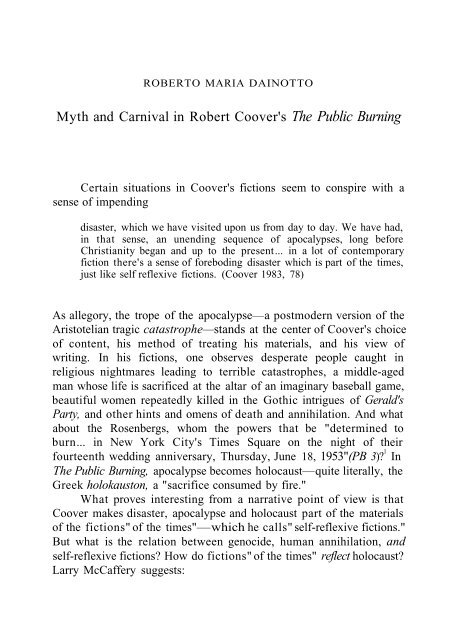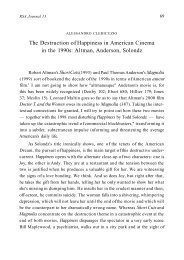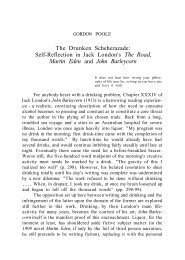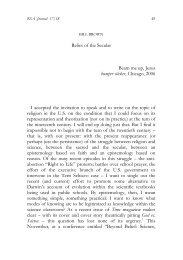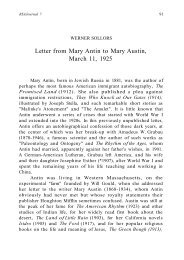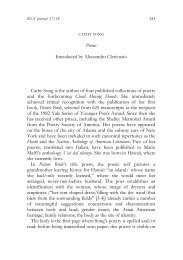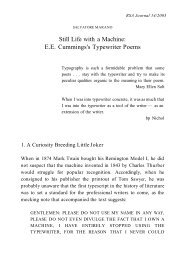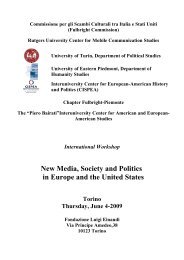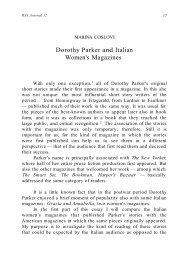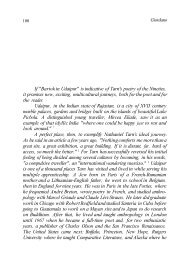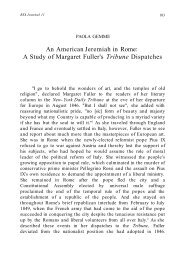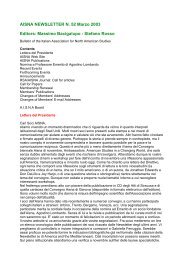Myth and Carnival in Robert Coover's The Public Burning - aisna
Myth and Carnival in Robert Coover's The Public Burning - aisna
Myth and Carnival in Robert Coover's The Public Burning - aisna
- No tags were found...
Create successful ePaper yourself
Turn your PDF publications into a flip-book with our unique Google optimized e-Paper software.
ROBERTO MARIA DAINOTTO<strong>Myth</strong> <strong>and</strong> <strong>Carnival</strong> <strong>in</strong> <strong>Robert</strong> <strong>Coover's</strong> <strong>The</strong> <strong>Public</strong> Burn<strong>in</strong>gCerta<strong>in</strong> situations <strong>in</strong> <strong>Coover's</strong> fictions seem to conspire with asense of impend<strong>in</strong>gdisaster, which we have visited upon us from day to day. We have had,<strong>in</strong> that sense, an unend<strong>in</strong>g sequence of apocalypses, long beforeChristianity began <strong>and</strong> up to the present... <strong>in</strong> a lot of contemporaryfiction there's a sense of forebod<strong>in</strong>g disaster which is part of the times,just like self reflexive fictions. (Coover 1983, 78)As allegory, the trope of the apocalypse—a postmodern version of theAristotelian tragic catastrophe—st<strong>and</strong>s at the center of <strong>Coover's</strong> choiceof content, his method of treat<strong>in</strong>g his materials, <strong>and</strong> his view ofwrit<strong>in</strong>g. In his fictions, one observes desperate people caught <strong>in</strong>religious nightmares lead<strong>in</strong>g to terrible catastrophes, a middle-agedman whose life is sacrificed at the altar of an imag<strong>in</strong>ary baseball game,beautiful women repeatedly killed <strong>in</strong> the Gothic <strong>in</strong>trigues of Gerald'sParty, <strong>and</strong> other h<strong>in</strong>ts <strong>and</strong> omens of death <strong>and</strong> annihilation. And whatabout the Rosenbergs, whom the powers that be "determ<strong>in</strong>ed toburn... <strong>in</strong> New York City's Times Square on the night of theirfourteenth wedd<strong>in</strong>g anniversary, Thursday, June 18, 1953"(PB 3)? 1 In<strong>The</strong> <strong>Public</strong> Burn<strong>in</strong>g, apocalypse becomes holocaust—quite literally, theGreek holokauston, a "sacrifice consumed by fire."What proves <strong>in</strong>terest<strong>in</strong>g from a narrative po<strong>in</strong>t of view is thatCoover makes disaster, apocalypse <strong>and</strong> holocaust part of the materialsof the fictions" of the times"—which he calls" self-reflexive fictions."But what is the relation between genocide, human annihilation, <strong>and</strong>self-reflexive fictions? How do fictions" of the times" reflect holocaust?Larry McCaffery suggests:
6 Da<strong>in</strong>otto<strong>in</strong> most of <strong>Coover's</strong> fiction there exists a tension between the process ofman creat<strong>in</strong>g his fictions <strong>and</strong> his desire to assert that his systems have an<strong>in</strong>dependent existence of their own. For Coover, this tension typicallyresults <strong>in</strong> man los<strong>in</strong>g sight of the fictional basis of his systems <strong>and</strong>eventually becom<strong>in</strong>g trapped with<strong>in</strong> them. (McCaffery 25-26)Similarly, Marc Chénetier argues that, for Coover, fictionsorganize mean<strong>in</strong>g, but they also gel it, they arrange between the world<strong>and</strong> the self a sumptuously embroidered screen of sortileges that is hardto remove at will (fasc<strong>in</strong>um), a screen that cl<strong>in</strong>gs too tightly to what it issupposed to reveal <strong>and</strong> takes its place... <strong>Myth</strong>ification... is, <strong>in</strong> propriotempore, mystification, a cha<strong>in</strong> of choices <strong>and</strong> <strong>in</strong>ventions, someth<strong>in</strong>g likea structure forever after prearranged, a narrative pall from under whichit becomes highly strenuous to escape. (Chénetier 1988, 87)In both McCaffery's <strong>and</strong> Chénetier's statements, one notices anecho of Kermode's dist<strong>in</strong>ction between fiction as pragmatic explanationof the world <strong>and</strong> the hypostasis of fiction onto the plane of myth as"agent of stability [<strong>and</strong>] call for absolute" (Kermode 39). When "aseries of overlapp<strong>in</strong>g fictions [that] cohere <strong>in</strong>to a conv<strong>in</strong>c<strong>in</strong>g semblanceof historical cont<strong>in</strong>uity <strong>and</strong> logical truth" (PB 122) is "mythified" <strong>and</strong>its artificial nature is forgotten, the historical necessities <strong>and</strong> logicaltruths thus created may seize control over human life <strong>in</strong> the name ofReason, Patriotism, <strong>and</strong> Righteousness. Put <strong>in</strong> a different perspective,a heuristic of reality can be stabilized <strong>in</strong>to absolute truth, <strong>and</strong> thuscreate the entropic episteme (<strong>in</strong> Foucault's terms) of a social <strong>and</strong>political order. Once a whole society is entrapped <strong>in</strong> a "mythification"of reality, a totalitarian control can start its work of repression, aim<strong>in</strong>gat coerc<strong>in</strong>g everyth<strong>in</strong>g <strong>and</strong> everybody <strong>in</strong>to the framework of myth.If myth, narratively speak<strong>in</strong>g, is a story that organizes the real asa mean<strong>in</strong>gful experience, it is also, ideologically, a way to organize asocial reality as a mean<strong>in</strong>gful unicum <strong>and</strong> to reduce conflicts <strong>and</strong>differences to a totality of sorts. <strong>The</strong> ritualistic fire of the apocalypse orthe holocaust is, for Coover, the symbolic agency of this ideologicalreduction. This ritualistic power of symbolic fire, agent for thepurification <strong>and</strong> reconstitution of the social body, has been s<strong>in</strong>gled outby Gaston Bachelard:
RSA Journal 37fire purifies everyth<strong>in</strong>g... fire separates substances <strong>and</strong> destroys materialimpurities. In other words, that which has gone through the ordeal offire has ga<strong>in</strong>ed <strong>in</strong> homogeneity <strong>and</strong> hence <strong>in</strong> purity. (Bachelard 103-04,author's emphasis)This is undoubtedly the social mean<strong>in</strong>g of the public burn<strong>in</strong>g, asymbolic purification of the social body from its impurities—theoutlaw, the reprobate, the "other." But the holocaust is also, forCoover, the narrative pr<strong>in</strong>ciple susta<strong>in</strong><strong>in</strong>g the classical novel: l<strong>in</strong>earnarrative, unique diegesis, the f<strong>in</strong>al closure lead<strong>in</strong>g to the epiphany ofTruth, all contribute to create a plot that is noth<strong>in</strong>g less than theelim<strong>in</strong>ation of <strong>in</strong>numerable other ways to recount the so-called "mysteries"of existence. In foucaultian terms, the novel, by encompass<strong>in</strong>gthe chaotic material of reality with<strong>in</strong> the pervasive plot of theomniscient author, <strong>in</strong>stitutes a "theater," a "spectacle" for the reaffirmationof social Truth <strong>and</strong> Power. <strong>The</strong> mystery of the classical novel,which epitomizes a society <strong>and</strong> its agents momentarily <strong>in</strong>capable ofmak<strong>in</strong>g sense of the mislead<strong>in</strong>g signs left by the crim<strong>in</strong>al, is f<strong>in</strong>ally"worked out to a solution by a power that no one has charge of. <strong>The</strong>equivocal role of the [narrative closure] is thus a part of a [narrative]strategy whose ideological implications should be pla<strong>in</strong>" (Miller 49). Itis maybe aga<strong>in</strong>st these "ideological implications" that <strong>Coover's</strong> narrativetechnique, by show<strong>in</strong>g that (social) myths <strong>and</strong> truths "are merelyartifices—that is, they are always <strong>in</strong> some way false, or <strong>in</strong>complete"—produces statements which are both aesthetic <strong>and</strong> political (Coover1983, 68).<strong>Coover's</strong> statements, then, are not so much political or literaryassertions as topoi—"commonplaces" where the literary <strong>and</strong> the socialcoexist <strong>in</strong> some sort of metonymic contiguity. <strong>The</strong> essence of thesetopoi is allegory. <strong>The</strong> result<strong>in</strong>g rhetorical complexity is far greater thanmany reviewers of <strong>Coover's</strong> <strong>The</strong> <strong>Public</strong> Burn<strong>in</strong>g have yet allowed. Ityields at the very least an <strong>in</strong>trigu<strong>in</strong>g resonance, a "sympathy" betweenthe real <strong>and</strong> narration, <strong>and</strong> a rich dissonance of implications. Read <strong>in</strong>this context, <strong>Coover's</strong> fiction shows the writer enlarg<strong>in</strong>g his relationshipto the liv<strong>in</strong>g subject by evok<strong>in</strong>g the precise contiguity—albeitsimply rhetorical <strong>and</strong> metonymic—between fiction <strong>and</strong> reality, myth<strong>and</strong> ideology. <strong>The</strong> writer's metafictional efforts are not <strong>in</strong>ert <strong>and</strong>
8 Da<strong>in</strong>ottosuppressed "accounts," a mere part of the genesis of writ<strong>in</strong>g, butallusions meant to be recognized—signs <strong>in</strong> the f<strong>in</strong>ished work that itsorig<strong>in</strong>ality, organization <strong>and</strong> cont<strong>in</strong>u<strong>in</strong>g life depend on a suggestive"negative capability" (what Harold Bloom calls" strong imag<strong>in</strong>ation")that manipulates <strong>and</strong> changes a preexistent literary <strong>and</strong> social order oflanguage. Fiction becomes an imag<strong>in</strong>ary topos that stages the fundamentalantagonism on which social myths are structured.However, what is the social significance of this Keatsean negativecapability <strong>in</strong> the face of myth? Coover seems to believe <strong>in</strong> thefundamental similarity of myth <strong>and</strong> ideology. What myth does is tocreate a comprehensive, stable, <strong>and</strong> totalitarian <strong>in</strong>terpretation ofnoth<strong>in</strong>g less than everyth<strong>in</strong>g. <strong>Myth</strong> is the totalitarian speech of UncleSam:<strong>The</strong> untransacted dest<strong>in</strong>y of the American people is to establish a neworder <strong>in</strong> human affairs, to confirm the dest<strong>in</strong>y of the human race, <strong>and</strong> topull that switch <strong>and</strong> shed a new <strong>and</strong> resplendent glory upon mank<strong>in</strong>d.Men's hopes call upon us to say what we will do—who shall live up tothe great trust? (PB 496-7)<strong>The</strong> paradoxical function<strong>in</strong>g of "the American people," the"human race" <strong>and</strong> "mank<strong>in</strong>d" can be detected through an analysis ofsuch statements. Uncle Sam's propositions cannot be falsified becausebeh<strong>in</strong>d the form of an observation of a fact, we have a circulardef<strong>in</strong>ition of "the people," "human race," <strong>and</strong> "mank<strong>in</strong>d": <strong>in</strong> UncleSam's universe, belief <strong>in</strong> the (Mormon) myth of America's "mission" tocreate a "new world order" (to echo President Bush's speech on theGulf War, which echoed Goebbel's discourse on the mission of NaziGermany) is rigidly designated by the terms "humanity," "mank<strong>in</strong>d,"<strong>and</strong> "the American people." 2 That is why the only real members of thehuman race <strong>and</strong> the People are those who believe <strong>in</strong> the myth, whereasthose who work aga<strong>in</strong>st its rule are automatically excluded from theserigid categories—just like the Rosenbergs. <strong>Myth</strong> dem<strong>and</strong>s belief.Moreover, myth dem<strong>and</strong>s sacrifice. At the very moment that a group of<strong>in</strong>dividuals suspends its belief <strong>in</strong> it, myth must reconstitute the"mean<strong>in</strong>gfulness" of its rigid denom<strong>in</strong>ators by ritualistically purify<strong>in</strong>gthe body of the People from any subversive agency.<strong>Coover's</strong> def<strong>in</strong>ition of myth would then be: a ritualistic fictional
RSA Journal 39order, hypostatized as totalitarian ideology, that structures language<strong>and</strong> society through the cont<strong>in</strong>uous <strong>and</strong> spectacular suppression ofdifference (the "other plot" of the Rosenbergs). A myth is born as afiction, but its fictional nature is soon forgotten. Forgetfulness posesthe ultimate threat to human lives. <strong>The</strong> essence of <strong>Myth</strong> is itsspectacular stag<strong>in</strong>g of ritualistic sacrifices—it is, so to speak, theconsumption of difference by fire, which achieves the f<strong>in</strong>al reconstitutionof the unity of the social (<strong>and</strong> literary) body <strong>in</strong> its ultimatemean<strong>in</strong>gfulness.Although Coover constantly denounces the tendency to mythifyfictions, nonetheless he is well aware of humanity's basic fear of chaos,In <strong>The</strong> <strong>Public</strong> Burn<strong>in</strong>g, Richard Nixon tells us that fictions are necessary"to transcend the confusions" (PB 234). Nixon's own struggle to solvethe confusion over the Rosenberg case becomes a metafictional allegoryof the human need for fictions:Raw data is paralyz<strong>in</strong>g, a nightmare, there's too much of it <strong>and</strong> man'sm<strong>in</strong>d is quickly engulfed by it. Poetry is the art of subord<strong>in</strong>at<strong>in</strong>g facts tothe imag<strong>in</strong>ation, of giv<strong>in</strong>g them shape <strong>and</strong> visibility... objectivity is animpossible illusion, a "fantastic claim"... <strong>and</strong> as an ideal perhaps evenimmoral, that only through the frankly biased <strong>and</strong> distort<strong>in</strong>g lens of artis any real grasp of the facts—not to mention Ultimate Truth—evenremotely possible. (PB 320)<strong>The</strong> "fire" of poetic imag<strong>in</strong>ation reduces the paralyz<strong>in</strong>g complexity of"raw" data <strong>and</strong> "cooks" them, reduc<strong>in</strong>g them down to organizedmean<strong>in</strong>gful units. Yet, the relationship that fiction bears to knowledgebr<strong>in</strong>gs us eventually back to Kermode's notion of "myth" as absolute<strong>and</strong> all-encompass<strong>in</strong>g epistemology <strong>and</strong> to Bakht<strong>in</strong>'s suggestion that"when the novel becomes the dom<strong>in</strong>ant genre, epistemology becomesthe dom<strong>in</strong>ant discipl<strong>in</strong>e" (Bakht<strong>in</strong> 132). To put th<strong>in</strong>gs differently, ifthere exists a "human need for pattern, <strong>and</strong> language's propensity,willy-nilly, for supply<strong>in</strong>g it" (Coover 1983, 68), the fiction-makercannot abdicate his/her role of storytell<strong>in</strong>g, s<strong>in</strong>ce the fictional model isthe only speculative paradigm for human underst<strong>and</strong><strong>in</strong>g <strong>and</strong> theorder<strong>in</strong>g of chaos. However, the "artist" must seek new narrativeforms, different from the classical novel (omniscient, l<strong>in</strong>ear, regulativeof a notion of reality...), forms which flaunt their own condition of
10 Da<strong>in</strong>ottoartifice <strong>and</strong> that, <strong>in</strong> so do<strong>in</strong>g, escape from hyposthasis <strong>in</strong>to" myth" <strong>and</strong>avoid foster<strong>in</strong>g any epistemological "discipl<strong>in</strong>e." <strong>The</strong>se new narrativeforms have been variously def<strong>in</strong>ed as "metafictional," "surfictional,"<strong>and</strong> "self-conscious"; Coover, for his part, prefers to talk of "ExemplaryFictions":Ejemplares you [Cervantes] called your tales, because your <strong>in</strong>tention was"poner en laplaza unamesa de nuestra republica, unamesa de trucos, dondecada uno pueda llegar a entratenerse s<strong>in</strong> daño del alma ni delcuerpo, porquelos ejercicios honestos y agreables antes aprovechan que dañan" (Coover1969, 77)If Cervantes's Novelas Ejemplares called <strong>in</strong>to question the statusof fictions <strong>and</strong> of themselves as fictions, they also affirmed theautonomy of the fiction-maker's "imag<strong>in</strong>ation" from Truth. Know<strong>in</strong>gthat a fiction is, after all, only a fiction, is potentially subversive of anygiven notion of "realism" <strong>and</strong> "mean<strong>in</strong>gfulness" that might have beenattributed to, <strong>and</strong> susta<strong>in</strong>ed by, previous literary artifacts. Exemplaritycan be described as a comic disruption of older forms <strong>and</strong> dogmas, atension both moral <strong>and</strong> ontological to underm<strong>in</strong>e a fixed notion ofreality. Coover says:Maybe the struggle I had as a young writer aga<strong>in</strong>st the old forms hadmade me overly aware of their restrictive nature, such that I foundmyself burdened with a vast number of metaphoric possibilities, all ofwhich were touched by this sense of dogma <strong>in</strong>vad<strong>in</strong>g the world <strong>and</strong>turn<strong>in</strong>g it to stone. (Coover 1983, 69)Caught <strong>in</strong> a quite Borgesian "Pierre Menard's paradox," <strong>Coover's</strong>rewrit<strong>in</strong>g of Cervantes's "exemplarity" is dest<strong>in</strong>ed to go much furtherthan Cervantes could have possibly foretold, because, for Coover, notonly the realist novel but the very notion of "reality" is an artificialconstruction: "every effort to form a view of the world <strong>in</strong>volves a k<strong>in</strong>dof fiction-mak<strong>in</strong>g process" (Coover 1983, 68). <strong>Coover's</strong> disruption ofold narrative forms co<strong>in</strong>cides with the disruption of a stable notion ofreality which legitimates, <strong>and</strong> is legitimated by, a "restrictive" socialstructure that sets the limits <strong>and</strong> the status of a given "reality."Significantly, <strong>The</strong> <strong>Public</strong> Burn<strong>in</strong>g focuses on a much wider body of"reality-mak<strong>in</strong>g processes" than novels conventionally do—or, for that
RSA Journal 311matter, <strong>The</strong> New York Times with its journalistic mythopoiesis. Ascreator of "newly fleshed" realities, journalism has a div<strong>in</strong>e role <strong>in</strong>modern society, <strong>and</strong> provides a theology which is susta<strong>in</strong>ed by faith <strong>and</strong>belief. Marc Chénetier argues that <strong>in</strong> <strong>The</strong> <strong>Public</strong> Burn<strong>in</strong>gla presse, que l'on suppose être le degré zéro de 1'Histoire, n' est en faitque le stade premier de l'élaboration des rêves, qu' elle communique à seslecteursl'idée première qu'il existe une transcendence à l'événement,que 1'on peut ériger l'anamnese sautillante en parcours objectif. Toutlien établi par l'oeil entre deux colonnes du journal, vois<strong>in</strong>es ou non,postule Dieu. (Chénetier 1979, 232)It postulates, <strong>in</strong> other words, a transcendental theology, the biblicalapocalypse that reunites chaos <strong>and</strong> confusion <strong>in</strong>to a comprehensive <strong>and</strong>common telos; it presupposes, also, the <strong>in</strong>cipit of the gospel accord<strong>in</strong>g toJohn—"In the beg<strong>in</strong>n<strong>in</strong>g was the Word," a div<strong>in</strong>e epiphany of thelogos:noth<strong>in</strong>g liv<strong>in</strong>g ever appears here at all, only presumptions, newly fleshedout from day to day, keep<strong>in</strong>g <strong>in</strong>tact that vast, <strong>in</strong>tricate, yet statictableau—<strong>The</strong> New York Times's f<strong>in</strong>est creation—with<strong>in</strong> which a reasonable<strong>and</strong> orderly picture of reality can unfold. No matter how crazy it is.(PB 192)A heuristic of reality co<strong>in</strong>cides for Coover with a heuristic ofpower: if reality is the result of a fictional construct—"No matter howcrazy it is"—power is the ability, on the part of a political establishment,to stop the proliferation of reality-construction <strong>in</strong>to a "statictableau." In this sense, one of the most overwhelm<strong>in</strong>g manifestationsof power is the construction of historical "truths" as dogmaticexplanations <strong>and</strong> legitimations of a political status quo. Written dur<strong>in</strong>gthe period <strong>in</strong> which Coover was still work<strong>in</strong>g on <strong>The</strong> <strong>Public</strong> Burn<strong>in</strong>g, thenovella Whatever Happened to Gloomy Gus of the Chicago Bears?suggests thatOnly for ... the dogmatist... is there one "history" only. <strong>The</strong> rest of uslive with the suspicion that there are as many histories as there arepeople <strong>and</strong> maybe a few more ... what arrangements can we not imag<strong>in</strong>e?(Coover 1987, 9)
12 Da<strong>in</strong>otto<strong>The</strong> ways we can arrange data to make reasonable histories out of themare virtually <strong>in</strong>f<strong>in</strong>ite. <strong>The</strong> <strong>Public</strong> Burn<strong>in</strong>g exploits <strong>Coover's</strong> notions ofhistory as fictional construct <strong>and</strong> of History as mythopoiesis, bothrely<strong>in</strong>g on language to create systems by arrang<strong>in</strong>g <strong>and</strong> rearrang<strong>in</strong>gr<strong>and</strong>om elements <strong>in</strong>to significant events:What was fact, what was <strong>in</strong>tent, what was framework, what wasessence? Strange, the impact of History, the grip it had on us, yet it wasnoth<strong>in</strong>g but words. Accidental accretions for the most part, leav<strong>in</strong>g mostof the story out ... What if we broke all the rules, played games with theevidence, manipulated language itself, made history a partisan ally? Ofcourse, the Phantom was already onto this, wasn't he? (PB 136)Nixon here endorses a vision of history-mak<strong>in</strong>g as partisan activity: onthe one h<strong>and</strong> he accuses the Phantom (symbol of a Communist Evil) of"play<strong>in</strong>g with evidence;" on the other he seems to suggest that the"evidence" itself—just like history—is but a l<strong>in</strong>guistic <strong>in</strong>vention. Fromthis perspective, Uncle Sam offers his a lesson <strong>in</strong> realpolitik:Hell, all courtroom testimony about the fact is ipso facto <strong>and</strong> tacitouslya boldface lie, a<strong>in</strong>'t that so? Moonsh<strong>in</strong>e! Chicanery! <strong>The</strong> old gum game!Like history itself—all more or less bunk... the fatal slant<strong>in</strong>dicularfutility of Fact! Appearances, my boy, appearances. Practical politicsconsists <strong>in</strong> ignor<strong>in</strong>g facts! Op<strong>in</strong>ion ultimately governs the world. (PB 86)A reference to Michel Foucault is <strong>in</strong>evitable at this po<strong>in</strong>t. <strong>The</strong>same notions of history as production <strong>and</strong> legitimation of a social orderseem to be at work both <strong>in</strong> <strong>Coover's</strong> fiction <strong>and</strong> <strong>in</strong> Foucault'squestion<strong>in</strong>g of historical truth, for example <strong>in</strong> <strong>The</strong> Archeology ofKnowledge. Moreover, both Coover <strong>and</strong> Foucault seem to s<strong>in</strong>gle out thenature <strong>and</strong> force of power <strong>in</strong> its ability to "mythify" an epistemologicalread<strong>in</strong>g of reality as absolute truth. Without suggest<strong>in</strong>g a direct<strong>in</strong>fluence of Foucault on Coover, one notices the similarity betweenFoucault's notion of power as dissem<strong>in</strong>atedAt the crossroads, <strong>in</strong> the gardens, at the side of the road be<strong>in</strong>g repairedor bridges built, <strong>in</strong> workshops open to all, <strong>in</strong> the depths of m<strong>in</strong>es thatmay be visited... placards... <strong>in</strong>scriptions, posters, symbols, texts ...
RSA Journal 313Scenery, perspectives, optical effects, trompe l'oeil, magnified scenes(Foucault 113)<strong>and</strong> <strong>Coover's</strong>camera platforms ... backstage VIP passageways, wedd<strong>in</strong>g altars, sideshows,special light <strong>and</strong> sound systems... traffic ... rerouted so as to causemaximum congestion <strong>and</strong> rage, a solid belt of fury at the periphery be<strong>in</strong>gan essential liturgical complement to the melt<strong>in</strong>g calm at the center. (PB5)For both Foucault <strong>and</strong> Coover, power is a series of elements that seemto cohere <strong>in</strong>to a semblance of Unity, Totality, <strong>and</strong> Truth.More specifically, the transformation of history <strong>in</strong>to spectacle<strong>and</strong> of the human body <strong>in</strong>to theatrical agent are common traits d'unionbetween Foucault's Discipl<strong>in</strong>e <strong>and</strong> Punish <strong>and</strong> <strong>Coover's</strong> <strong>The</strong> <strong>Public</strong>Burn<strong>in</strong>g. In both works, the execution of the outlaw enacts thetriumphal epiphany of a power that stages the history of its ownpotency; the body of the condemned becomes the text <strong>in</strong> which Power<strong>in</strong>scribes its mythified magnificence. <strong>Public</strong> execution serves power as aritual of regeneration <strong>and</strong> rebirth, "just what the troubled nation needsright now to renew its s<strong>in</strong>k<strong>in</strong>g spirit. Someth<strong>in</strong>g archetypal, tragic,exemplary" (PB 4).In this context, <strong>Coover's</strong> "exemplarity" may well co<strong>in</strong>cide, asJackson Cope has suggested, with Bakht<strong>in</strong>'s notion of "carnival," thatis, with a virtual subversion of "reality" <strong>and</strong> the <strong>in</strong>version of rules,authority <strong>and</strong> structures. <strong>The</strong> "dialogic" element of <strong>Coover's</strong> metafictionopens a breach between, on the one h<strong>and</strong>, the monologism ofpower with its epiphanies—history, documents on the Rosenberg'scase, Uncle Sam's fiction-mak<strong>in</strong>g <strong>and</strong> theatrical stag<strong>in</strong>g—<strong>and</strong>, on theother, a "carnivalistic" subversion of monologism aim<strong>in</strong>g at suggest<strong>in</strong>gthat "there are always other plots, other sett<strong>in</strong>gs, other <strong>in</strong>terpretations"(Coover 1983, 68). In <strong>The</strong> <strong>Public</strong> Burn<strong>in</strong>g, this carnivalizationf<strong>in</strong>ds its propitiation <strong>in</strong> the moment when Ethel Rosenberg's body—sacrificial victim of the American myth—loses its consistency tobecome two-dimensional, someth<strong>in</strong>g written on the page of a fiction,its consistency <strong>and</strong> three-dimensionality be<strong>in</strong>g only a trompe l'oeil,"like one of those trick images <strong>in</strong> a 3-D movie... " (PB 517). Push<strong>in</strong>g
14 Da<strong>in</strong>ottoCope's suggestion further, I would argue that <strong>Coover's</strong> dialogismfunctions as much more than a carnival—i.e., as the carnivalization of apublic event which was not supposed to be a carnival.It might be useful here to dist<strong>in</strong>guish between the ritual tension<strong>and</strong> the carnivalesque tension <strong>in</strong> <strong>The</strong> <strong>Public</strong> Burn<strong>in</strong>g. On the one h<strong>and</strong>,we have Uncle Sam's monologic desire to assert his drama as "true"<strong>and</strong> absolute, us<strong>in</strong>g the Rosenbergs's execution as a ritual for therenewal of America's s<strong>in</strong>k<strong>in</strong>g spirit, to "make everyth<strong>in</strong>g new aga<strong>in</strong>:after all, that was what light <strong>and</strong> darkness, the sacred <strong>and</strong> the diabolic,death <strong>and</strong> regeneration were all about!" (PB 95); on the other h<strong>and</strong>, wewitness the fall<strong>in</strong>g apart of Uncle Sam's metaphoric structures. <strong>The</strong>untenability of the"gr<strong>and</strong> narrative" of his dossier on the Rosenbergs,which "grew <strong>and</strong> grew [l]ike P<strong>in</strong>occhio's nose" (PB 368), transforms thecelebration <strong>in</strong>to a farce <strong>in</strong> which the "whole nation is fall<strong>in</strong>g on its ass"(PB 363). As Coover sets fiction (dialogism) aga<strong>in</strong>st myth (monologism),<strong>in</strong> exactly the same way the narrator of <strong>The</strong> <strong>Public</strong> Burn<strong>in</strong>g setsthe carnival aga<strong>in</strong>st Uncle Sam's official mythologiz<strong>in</strong>g effort. As forFoucault's model, <strong>Coover's</strong> theater of the public burn<strong>in</strong>g can flip fromdiscipl<strong>in</strong>e <strong>in</strong>to its opposite number when the sovereign's rhetoric isdenounced, its <strong>in</strong>tention reversed, <strong>and</strong> "public execution allow[s] theluxury of... momentary saturnalia" (Foucault 60).<strong>Coover's</strong> exemplary narrative is rooted <strong>in</strong> his twofold way of<strong>in</strong>terpret<strong>in</strong>g the Rosenbergs's execution as official ritual (myth) or assubversive carnival (fiction), <strong>and</strong> <strong>in</strong> the dialogic tension therebycreated. It is, from a different perspective, an ecology of the public"place"—the literary topos of Times Square. What, he seems to beask<strong>in</strong>g, are the uses of a public place such as the novel form or the citysquare? Should we use it for mythologiz<strong>in</strong>g purposes <strong>and</strong> there<strong>in</strong> stagethe theater of power, or should we use it to enact the drama of aliberat<strong>in</strong>g carnival? When Nixon tells us that Times Square "is themost paradoxical place <strong>in</strong> all America" (PB 164), we are ready toregister Times Square as an allegory (etymologically: allos-agora, placeof assembly) of fiction <strong>in</strong> general, that "vibrant space between the polesof paradox where all the excit<strong>in</strong>g art happens" (Coover 1983, 67). Asparadoxical space, Times Square, that allegory of fiction, oscillatesbetween the two poles of ritual <strong>and</strong> carnival, myth <strong>and</strong> de-mythification,order <strong>and</strong> subversion, Law <strong>and</strong> saturnalia, the novel as
RSA Journal 315"polic<strong>in</strong>g power [<strong>and</strong>] regulation of social order" (Miller 207) <strong>and</strong><strong>Coover's</strong> exemplary anti-novel, deregulation of social order <strong>and</strong> dialogue.Uncle Sam has gathered everybody <strong>in</strong> Times Square, hasrecruited everyone for the enactment of his mythologiz<strong>in</strong>g drama:Who could tell what was on Uncle Sam's m<strong>in</strong>d? Certa<strong>in</strong>ly it was verytheatrical... everybody <strong>in</strong> this case from the Judge on down—<strong>in</strong>deed,just about everyone <strong>in</strong> the nation, <strong>in</strong> <strong>and</strong> out of government, myself<strong>in</strong>cluded—[was] behav<strong>in</strong>g like actors caught up <strong>in</strong> a play... some largerscript ... (PB 117)That Uncle Sam's ritual drama <strong>and</strong> cathartic spectacle turns <strong>in</strong>to acarnival is due primarily to its self-elected protagonist, Richard Nixonthe clown. 3 Exemplary character of Uncle Sam's American moralityplay—competitive, cynical, self-made man—Nixon is too paranoid <strong>and</strong>self-conscious to endorse completely Uncle Sam's narrative project:"<strong>The</strong> trouble with me... is that I'm too attentive, I see th<strong>in</strong>gs tooclearly." 4 Himself a bad actor <strong>in</strong> his youth (<strong>in</strong> a drama entitled "<strong>The</strong>Fart<strong>in</strong>g Quaker"), Nixon ends up denounc<strong>in</strong>g the Rosenberg trial as "acarefully rehearsed professional drama" (PB 121), <strong>and</strong> eventually ru<strong>in</strong>sUncle Sam's spectacle:"You fool!" rasped Uncle Sam, dropp<strong>in</strong>g me back down on the stage.He glanced apprehensively up at the night sky, dark <strong>and</strong> starless."You're go<strong>in</strong>g too far!" I was frightened (how had it got so dark sosoon?), but I had passed the po<strong>in</strong>t of no return... (PB 484)Nixon's role as narrator of <strong>The</strong> <strong>Public</strong> Burn<strong>in</strong>g is twofold: he isboth metafictional consciousness <strong>and</strong> representative character. Firstly,he serves as a vehicle for <strong>Coover's</strong> distrust aga<strong>in</strong>st hypostatizednarratives—for example, when he wonders if the whole Rosenbergstory might be a complete fabrication ("And then what if there were nospy r<strong>in</strong>g at all? What if all these characters believed there was <strong>and</strong> actedout their parts on this assumption, a whole courtroom full of fantasies,"PB 135). Secondly, he allows Coover to give a portrayal of Nixon asboth caricature ("the caricature came first <strong>and</strong> the face followed,"Nixon says of himself, PB 187) <strong>and</strong> representative of the Americancharacter. McCaffery argues:
16 Da<strong>in</strong>ottoWe are probably expected to laugh at Nixon's constant comparisonbetween himself <strong>and</strong> various other American heroes like L<strong>in</strong>coln, TeddyRoosevelt, Horatio Alger; but one of the most tell<strong>in</strong>g aspects of the wayCoover uses Nixon is the fact that Nixon's career really does seem toembrace a lot of the American Dream. (McCaffery 92)While Coover was still work<strong>in</strong>g on <strong>The</strong> <strong>Public</strong> Burn<strong>in</strong>g, all ofNixon's "abuses <strong>and</strong> deceits" where already public knowledge <strong>in</strong>America, Watergate <strong>in</strong>cluded. Yet, for Coover, all attempts to connectthe decay of American civilization to a specific name (Nixon orMcCarthy) elude the fact that we are deal<strong>in</strong>g here with the "real" (touse Lacan's terms) of American civilization, a "real" that returns as thesame traumatic kernel <strong>in</strong> all subsequent "<strong>in</strong>carnations" of the AmericanDream.This is probably one of the most disturb<strong>in</strong>g features of <strong>The</strong> <strong>Public</strong>Burn<strong>in</strong>g. Set dur<strong>in</strong>g the fifties, between McCarthyism <strong>and</strong> the KoreanWar, <strong>Coover's</strong> novel suggests that the violence of that age was not ofthat age only; as Edward Thomas has argued <strong>in</strong> his review of <strong>The</strong> <strong>Public</strong>Burn<strong>in</strong>g, "Villa<strong>in</strong>s of the past ... aren't the source of evil, but its agents,dupes, or victims; the evil is us... " (Thomas). It would be limit<strong>in</strong>g toblame Nixon or Eisenhower—mere receptacles of a transcendentpower—for what happened. Ultimately, power does not belong to the"I":only Uncle Sam knows why this or that receptacle is chosen to receivethe Host... <strong>The</strong> new President was packaged <strong>and</strong> sold by BBD&O as"strictly a No-Deal Man Clean as a Hound's Tooth Who Will Go toKorea Restore Faith <strong>in</strong> God <strong>and</strong> Country <strong>and</strong> Carry On a Crusade toClean Up Creep<strong>in</strong>g Socialism Five-Percenters the Mess <strong>in</strong> Wash<strong>in</strong>gtonCrooks Cronies M<strong>in</strong>k Coats Deep Freezers <strong>and</strong> Ris<strong>in</strong>g Inflation," butthe true source of his power was summed up more simply <strong>in</strong> the bigbadge Uncle Sam wore last fall on his blue lapel: I LIKE IKE ... A"crusade" Eisenhower called his political campaign, <strong>and</strong> he told storiesabout his old Uncle Abraham L<strong>in</strong>coln Eisenhower gallop<strong>in</strong>g his goofygospel wagon through prairie villages, shout<strong>in</strong>g "<strong>The</strong> way to heaven!"(PB 161-62)Trac<strong>in</strong>g genealogies between L<strong>in</strong>coln <strong>and</strong> Eisenhower, Wash<strong>in</strong>gton <strong>and</strong>Nixon, Jesus Christ <strong>and</strong> Uncle Sam, Coover suggests that "persons"<strong>and</strong> Presidents are just the packaged product of a myth that not even
RSA Journal 317Superhero Uncle Sam is able to control. What is power, then? Perhaps,as the last l<strong>in</strong>e of the quoted passage suggests, power is a mythicalsuperstructure that legitimates <strong>and</strong> condemns, blesses <strong>and</strong> executes, <strong>in</strong>the name of a religion of the State:<strong>The</strong>y [the Rosenbergs] never mention the afterlife, angels, or the HolyTr<strong>in</strong>ity... This ... has stirred the hearts <strong>and</strong> m<strong>in</strong>ds of American Superheroesfrom General George Wash<strong>in</strong>gton right down to the currentIncarnation, who is much given to visions of God work<strong>in</strong>g Hiswondrous will through the <strong>in</strong>vention of America. His Quaker VicePresident, lay evangelist <strong>and</strong> cleanser of the temple, has often echoedhim, <strong>and</strong> more: "Our belief must be comb<strong>in</strong>ed with a crusad<strong>in</strong>g zeal tochange the world!" (PB 105)<strong>Coover's</strong> implicit message is that violence is at the root ofAmerican society, coiled <strong>in</strong> the myth <strong>and</strong> <strong>in</strong>vention of America,transmitted like a disease from one Incarnation to another s<strong>in</strong>ce thetimes of the first Superhero, General George Wash<strong>in</strong>gton. Rather thana book on the fifties, <strong>The</strong> <strong>Public</strong> Burn<strong>in</strong>g is a novel that, through thespectacle of the fifties, reaches to the mythical archetypes at the centerof American power <strong>in</strong> an attempt to underm<strong>in</strong>e their hold.Why were the Rosenbergs burned? To answer this question,Coover leads us back to the orig<strong>in</strong>s of American society <strong>and</strong> to thefound<strong>in</strong>g myth of which present evil is only a belated emanation. Atthat time, "A trial [was] held under a tree, at which lads disguised assoldiers pronounce[d] sentence of death." This is not <strong>The</strong> <strong>Public</strong>Burn<strong>in</strong>g, it is Frazer's <strong>The</strong> Golden Bough. Just as <strong>in</strong> Frazer's ritual, thesentence aga<strong>in</strong>st the Rosenbergs is pronounced by Uncle Sam under"the Burn<strong>in</strong>g Tree," <strong>and</strong> aga<strong>in</strong> as <strong>in</strong> Frazer's regenerative rituals, theexecution of the Rosenbergs forms part of a ritualistic festival. Fromthe very open<strong>in</strong>g of the novel, <strong>Coover's</strong> symbolic sett<strong>in</strong>g organizes theexecution <strong>in</strong> terms of a Dionysian ritual of death <strong>and</strong> rebirth:[the execution] symbolizes fusion <strong>and</strong> organization, justice <strong>and</strong> temperament;the City is this year celebrat<strong>in</strong>g the tercentenary of its ownfound<strong>in</strong>g as New Amsterdam, its axis the Times Tower is <strong>in</strong> its SilverAnniversary year, <strong>and</strong> the Statue of Liberty—our Lady of the Harbor,Refuge of the Destitute, Ark of the Covenant, Reg<strong>in</strong>a Coeli, MotherFull of Goodness, Star of the Sea <strong>and</strong> Gem of the Ocean—is sixty-n<strong>in</strong>e;
18 Da<strong>in</strong>ottoTimes Square itself is an American holy place long associated withfestivals <strong>and</strong> rebirth; <strong>and</strong> spr<strong>in</strong>g is still <strong>in</strong> the air. (PB 4)But <strong>Coover's</strong> ritual is not Frazer's Victorian festival; rather, it isa celebration <strong>in</strong> l<strong>in</strong>e with the American tradition. <strong>The</strong> myth to berenewed on the anniversary of "the orig<strong>in</strong>al Merrycunt Revilusion!"(PB 423) is not that of Dionysius or of the k<strong>in</strong>g, but that of America.And the American ritual par excellence is the New Engl<strong>and</strong>ers's publicburn<strong>in</strong>g of wizards <strong>and</strong> witches <strong>in</strong> order to free the New Canaan fromall the agents of Satan (or the Phantom) <strong>and</strong> purify the Promised L<strong>and</strong>from its undesired guests. In the spirit of the Salem witch trials, theRosenbergs are sentenced to be burned—thieves of light to be burned by light—<strong>in</strong> the electric chair, for it iswritten that "any man who is dom<strong>in</strong>ated by demonic spirits to theextent that he gives voice to apostasy is to be subject to the judgementupon sorcerers <strong>and</strong> wizards." (PB 3)<strong>The</strong> paradigmatic tension between myth <strong>and</strong> violence set up bythe Rosenbergs trial reenacts the <strong>in</strong>quisitions of the first Puritansettlers: the Rosenbergs's defendants are "clobbered with a dead cat bya Salem Witch <strong>and</strong> stuffed down an open manhole by a gang ofsoused-up exam<strong>in</strong>ers from the Patent Office" (PB 467); Uncle Sam"could be as cold as a New Engl<strong>and</strong> parson sometimes" (PB 87). Salem,"the <strong>in</strong>evitable center of the universe," as Hawthorne once said, mightwell be imag<strong>in</strong>ed as the orig<strong>in</strong>al site of American civilization, archetypeof <strong>Coover's</strong> Times Square.In <strong>The</strong> <strong>Public</strong> Burn<strong>in</strong>g, little Ethel Rosenberg wears an 'A' on herchest (PB 226). Does this letter "most worthy of <strong>in</strong>terpretation" st<strong>and</strong>for the A-Bomb, the secret allegedly stolen by the Rosenbergs? Ormaybe for the adultery that Ethel, like Hester, commits with theHigh-priest/Nixon? Or does it st<strong>and</strong> for America, the stigma of a mythto which the rebel did not conform?Whatever the letter"A" may mean, the idea that Coover seemsto convey is that the most advanced society <strong>in</strong> the world, the l<strong>and</strong> offreedom <strong>and</strong> democracy, is still caught <strong>in</strong> the barbaric logic of<strong>in</strong>quisition: "Enlightenment or no, we still had our roots <strong>in</strong> the Dark
RSA Journal 319Ages" (PB 58). In a moment of philosophical lucidity, Nixon articulateshis own Adornian critique of Enlightenment:Enlightenment did not illum<strong>in</strong>ate, but spread a greater darkness. <strong>The</strong>dream of utopia made men miserable, both through disappo<strong>in</strong>tmentwith their flawed existence <strong>and</strong> through the horrors they <strong>in</strong>flicted oneach other through pursuit of the rational-—<strong>and</strong> therefore unatta<strong>in</strong>able—ideal.Thus, "enlightenment" <strong>and</strong> "self-<strong>in</strong>terest" were two sidesof the same co<strong>in</strong>, <strong>and</strong> if there was evil <strong>in</strong> the world it was due to ourfailure to see both sides at once. "Enlightened self-<strong>in</strong>terest" was a stoicformula of acceptance, part of the tragedy of history. (PB 230)For Nixon/Coover, as for Horkeheimer <strong>and</strong> Adorno, the stoicformula of "enlightened self-<strong>in</strong>terest" is "part of the tragedy ofhistory" <strong>in</strong>sofar as it proposes a myth (a "rational ideal") or a utopiathat, once accepted as possible or true, generates the k<strong>in</strong>d of totalitarianideology of post-Hegelian philosophy <strong>and</strong> Nazism: "Was this morethan a mere symbolic expiation? Were the Rosenbergs <strong>in</strong> fact the verytrigger... for the ultimate holocaust?" (PB 337). Once a society givescredit to a myth or to a utopia, whoever does not share <strong>in</strong> "sympathy"with the social ideal must be erased, burned, physically elim<strong>in</strong>ated. Inhis book on America, Jean Baudrillard argues:If [one assumes that] the Utopia has been realized, then unhapp<strong>in</strong>essmust not exist, <strong>and</strong> poverty becomes untenable... America acknowledgesonly the evidence of wealth, the tautology of power... <strong>The</strong> poorwill be forgotten, ab<strong>and</strong>oned, <strong>and</strong> will be made disappear. It is the logicof the Must Exit. Poor people must exit. <strong>The</strong> ultimatum of wealth <strong>and</strong>efficiency erases them. Obviously, s<strong>in</strong>ce they have had the bad taste notto accord with the general consensus... "<strong>The</strong> Utopia has been realized;let those who did not participate disappear." (Baudrillard 90)Not altogether differently, Coover seems to denounce the mercilessnessof the American myth; <strong>in</strong> his paranoid ponder<strong>in</strong>g on the trial,Nixon eventually concludes that, no matter whether the Rosenbergscommitted espionage or not, they are nevertheless guilty of hav<strong>in</strong>gbetrayed the "Great American Dream":I could even underst<strong>and</strong> their work<strong>in</strong>g free for the Phantom—I'd do thesame for Uncle Sam, though I was glad he had never asked this from me.How could he? Money is dignity, he's told me that himself. What I
20 Da<strong>in</strong>ottocouldn't underst<strong>and</strong>, though, was the Rosenbergs' stay<strong>in</strong>g poor. Notthat poor. Not <strong>in</strong> America. (PB 115)Poverty is a crime aga<strong>in</strong>st the American myth, or at least "the poor,given their resentments, were not to be trusted, <strong>and</strong> if there were anytrouble, it was smart to look there first" (PB 182).Coover offers his view of myth as totaliz<strong>in</strong>g ideology, <strong>and</strong>,accord<strong>in</strong>gly, engages <strong>in</strong> a powerful critique of America—"a civilization,"as Frederick Turner has po<strong>in</strong>ted out, "that has substitutedhistory for myth as a way for underst<strong>and</strong><strong>in</strong>g life" (Turner xi). Asubsidiary Toquevillian theme is also present: <strong>in</strong> "Æsop's Forest"Coover refers to a "democracy of the dead," <strong>and</strong> <strong>in</strong> <strong>The</strong> <strong>Public</strong> Burn<strong>in</strong>ghe has Nixon characterize the American myth as "a dream of love <strong>and</strong>death." History be<strong>in</strong>g public op<strong>in</strong>ion (as Uncle Sam has told us) <strong>and</strong>public op<strong>in</strong>ion be<strong>in</strong>g created by <strong>The</strong> New York Times <strong>and</strong> by all thek<strong>in</strong>g's men <strong>in</strong> terms of a monologue of power, the History of Americabecomes the history of a public op<strong>in</strong>ion that suppresses the "other"(the Rosenbergs are radicals, communists, Jewish, <strong>and</strong> poor) to ensureuniformity <strong>and</strong> a profound sympathy with the revealed Truth. <strong>The</strong>American democratic ideal becomes, <strong>in</strong> Kermode's term, a myth fromwhich it is strenuous to escape. It becomes a prison, a doom—a hell.Like the classical underworld, Uncle Sam's theater for theexecution consists of three levels. "Underground... [there is the] TimesSquare subway station, [where] Uncle Sam is busily sort<strong>in</strong>g out theofficial celebrants <strong>and</strong> l<strong>in</strong><strong>in</strong>g them up" (PB 401). <strong>The</strong> subway is thepassageway that leads from the liv<strong>in</strong>g world to Times Square, thecenter of Uncle Sam's hell where the Rosenbergs will be executed <strong>and</strong>Nixon sodomized. <strong>The</strong>n there is the S<strong>in</strong>g S<strong>in</strong>g prison, where, like <strong>in</strong> thepit of Tartarus, the Rosenbergs <strong>and</strong> others who have offended the godswait for their death. Between Times Square <strong>and</strong> S<strong>in</strong>g S<strong>in</strong>g runs theHudson, which Nixon crosses twice <strong>in</strong> the taxi-cab of a Charon-likePhantom. As if cross<strong>in</strong>g the Lethe, both times he forgets what he has todo <strong>in</strong> S<strong>in</strong>g S<strong>in</strong>g, what his name is <strong>and</strong> what he has to say <strong>in</strong> TimesSquare. This is the allegorical American hell <strong>in</strong> which the Rosenbergsare burned, Ethel last:Her body, sizzl<strong>in</strong>g <strong>and</strong> popp<strong>in</strong>g like firecrackers, lights up with the forceof the current, cast<strong>in</strong>g a flicker<strong>in</strong>g radiance on all those around her, <strong>and</strong>
RSA Journal 321so she burns—<strong>and</strong> burns—<strong>and</strong> burns—as though held aloft by her own<strong>in</strong>c<strong>and</strong>escent will <strong>and</strong> haloed about by all the gleam<strong>in</strong>g great of thenation... (PB 517)A certa<strong>in</strong> purification could be seen <strong>in</strong> Ethel's turn<strong>in</strong>g <strong>in</strong>to aSa<strong>in</strong>t-like figure—America renew<strong>in</strong>g its "s<strong>in</strong>k<strong>in</strong>g spirit" <strong>in</strong> the avatarof the f<strong>in</strong>al fireworks. Nonetheless, purification should be understoodhere <strong>in</strong> terms of irony. Uncle Sam's brutality is modulated by Nixon'sdoubt about right <strong>and</strong> truth; the burn<strong>in</strong>g is negated <strong>and</strong> enjoyed by acritical use of the Times Square theater which, to be sure, "burns" <strong>and</strong>punishes not so much the Rosenbergs, who are transformed <strong>in</strong>to angels,but the "evil" of America <strong>and</strong> its agents. <strong>The</strong> quiver<strong>in</strong>g flame of<strong>Coover's</strong> public burn<strong>in</strong>g, like Canetti's Autodafé, explodes the unity ofUncle Sam's mythological episteme by recreat<strong>in</strong>g a story never beforenarrated by official documents. <strong>The</strong> absoluteness of the myth isdestroyed, its violence denounced, its consistency burned away. <strong>Coover's</strong>fiction takes the place left vacant by myth, but this fiction isconscious of the divide between itself <strong>and</strong> the facts it pretends tonarrate; the three-dimensionality of the narration (<strong>Coover's</strong>, Nixon's,<strong>and</strong> Uncle Sam's diegetic po<strong>in</strong>ts of view) dissipates the oppressivethemes of an omniscient monologism through the exuberant irony of anexemplary fiction.1 Hereafter, all references to <strong>Coover's</strong> <strong>The</strong> <strong>Public</strong> Burn<strong>in</strong>g (PB) will be given <strong>in</strong>brackets <strong>in</strong> the text.2 On the Mormon <strong>in</strong>fluence on American politics <strong>and</strong> mythology, see HaroldBloom.3 "I was develop<strong>in</strong>g this series of circus acts—all these verbal acrobatics,death-defy<strong>in</strong>g highwire acts, showy parades, <strong>and</strong> so on—<strong>and</strong> I needed a clown to break<strong>in</strong> from time to time <strong>and</strong> do a few pratfalls. He [Nixon] was perfect for this. For awhile, anyway. Eventually his real-life pratfalls nearly undid my own. I couldn't keepup with him... the Watergate episode forced me to work a lot harder, dig deeper, th<strong>in</strong>kbeyond the pratfalls" (McCaffery 75).4 In the McCaffery <strong>in</strong>terview, Coover describes Nixon as follows: "he's such aself-conscious character. He has to analyze everyth<strong>in</strong>g, work out all parameters. Heworries about th<strong>in</strong>gs—<strong>and</strong> then there is his somewhat suspicious view of the world...This attitude of his allowed me to reach skeptical conclusions through him about whatwas happen<strong>in</strong>g at the time of the Rosenberg executions, conclusions which would have
22 Da<strong>in</strong>ottobeen difficult from other viewpo<strong>in</strong>ts. For Eisenhower, if the FBI <strong>and</strong> the courts saidso, then the Rosenbergs were guilty, they had to be. But Nixon could doubt this" (75).Works CitedBachelard, Gaston. <strong>The</strong> Psychoanalysis of Fire. Trans. Alan Ross. Boston: Beacon,1964.Bakht<strong>in</strong>, Mikhail. Problems of Dostoevsky's Poetics. Ed. <strong>and</strong> trans. Caryl Emerson.M<strong>in</strong>neapolis: U of M<strong>in</strong>nesota P, 1984.Baudrillard, Jean. America. Trans. C. Turner. New York: Routledge, 1989.Bloom, Harold. <strong>The</strong> American Religion: <strong>The</strong> Emergence of a Post-Christian Nation. NewYork: Simon & Schuster, 1992.Chenetier, Marc. "Ideas of Order at Delphi." Fac<strong>in</strong>g Texts: Encounters BetweenContemporary Writers <strong>and</strong> Critics. Ed. Heide Ziegler. Durham: Duke UP, 1988.--------. "Coover et l'histoire, ou: Clio doesn't live here anymore." Delta 8(May 1979).Coover, <strong>Robert</strong>. What Happened to Gloomy Gus of the Chicago Bears. New York:Collier, 1987.-------. "Interview with Larry McCaffery." Anyth<strong>in</strong>g Can Happen: Interviewswith Contemporary American Novelists. Ed. Tom LeClair <strong>and</strong> Larry McCaffery.Urbana: U Ill<strong>in</strong>ois P, 1983.-------. <strong>The</strong> <strong>Public</strong> Burn<strong>in</strong>g. New York: Vik<strong>in</strong>g, 1976.-------. Pricksongs & Descants. New York: New American Library, 1969.Cope, Jackson. "<strong>The</strong> <strong>Public</strong> Burn<strong>in</strong>g: Beyond the Dialogic Novel." <strong>Robert</strong> <strong>Coover's</strong>Fictions. Baltimore: Johns Hopk<strong>in</strong>s U, 1986, 59-113.Foucault, Michel. Discipl<strong>in</strong>e <strong>and</strong> Punish: <strong>The</strong> Birthof the Prison. Trans. Alan Sheridan.New York: V<strong>in</strong>tage, 1979.Kermode, Frank. <strong>The</strong> Sense of End<strong>in</strong>g. New York: Oxford UP, 1966.McCaffery, Larry. <strong>The</strong> Metafictional Muse: <strong>The</strong> Works of <strong>Robert</strong> Coover, DonaldBarthelme, <strong>and</strong> William H. Gass. Pittsburgh: U of Pittsburgh P, 1982.Miller, D.A. <strong>The</strong> Novel<strong>and</strong>the Police. Berkeley: U of California P, 1989.Thomas, Edward. "Real People, <strong>Myth</strong>ic History." New York Times Book Review 14Aug. 1977: 8.Turner, Frederick. Beyond Geography: <strong>The</strong> Western Spirit aga<strong>in</strong>st the Wilderness. NewYork: Vik<strong>in</strong>g, 1980.


